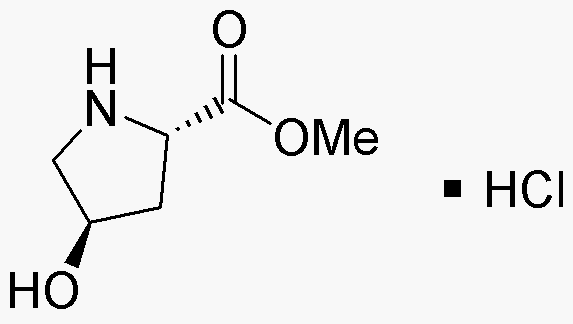trans-L-4-Hydroxyproline methyl ester hydrochloride is widely utilized in research focused on:
- Pharmaceutical Development: This compound is used in the synthesis of various pharmaceuticals, particularly in the development of drugs targeting collagen-related diseases, enhancing skin elasticity and wound healing.
- Biochemistry Research: It serves as a valuable building block in peptide synthesis, allowing researchers to study protein folding and stability, which is crucial in understanding various biological processes.
- Cosmetic Formulations: The compound is incorporated into skincare products due to its moisturizing properties, helping to improve skin texture and hydration, making it popular in the cosmetic industry.
- Food Industry: It is utilized as a food additive to enhance flavor and nutritional profile, particularly in products aimed at improving gut health and overall wellness.
- Material Science: This chemical is explored in the development of biodegradable polymers, contributing to sustainable materials that reduce environmental impact while maintaining performance.
Información general
Propiedades
Seguridad y normativas
Aplicaciones
trans-L-4-Hydroxyproline methyl ester hydrochloride is widely utilized in research focused on:
- Pharmaceutical Development: This compound is used in the synthesis of various pharmaceuticals, particularly in the development of drugs targeting collagen-related diseases, enhancing skin elasticity and wound healing.
- Biochemistry Research: It serves as a valuable building block in peptide synthesis, allowing researchers to study protein folding and stability, which is crucial in understanding various biological processes.
- Cosmetic Formulations: The compound is incorporated into skincare products due to its moisturizing properties, helping to improve skin texture and hydration, making it popular in the cosmetic industry.
- Food Industry: It is utilized as a food additive to enhance flavor and nutritional profile, particularly in products aimed at improving gut health and overall wellness.
- Material Science: This chemical is explored in the development of biodegradable polymers, contributing to sustainable materials that reduce environmental impact while maintaining performance.
Documentos
Hojas de datos de seguridad (HDS)
La SDS proporciona información de seguridad completa sobre la manipulación, el almacenamiento y la eliminación del producto.
Especificación del producto (PS)
La PS proporciona un desglose completo de las propiedades del producto, incluida la composición química, el estado físico, la pureza y los requisitos de almacenamiento. También detalla los rangos de calidad aceptables y las aplicaciones previstas del producto.
Certificados de análisis (COA)
Busque certificados de análisis (COA) ingresando el número de lote del producto. Los números de lote y de partida se pueden encontrar en la etiqueta de un producto después de las palabras "Lote" o "Lote".
Número de catálogo
Número de lote/lote
Certificados de origen (COO)
Este certificado de origen confirma el país en el que se fabricó el producto y también detalla los materiales y componentes utilizados en él y si se deriva de fuentes naturales, sintéticas u otras fuentes específicas. Este certificado puede ser necesario para cumplir con las normativas aduaneras, comerciales y regulatorias.
Número de catálogo
Número de lote/lote
Hojas de datos de seguridad (HDS)
La SDS proporciona información de seguridad completa sobre la manipulación, el almacenamiento y la eliminación del producto.
DownloadEspecificación del producto (PS)
La PS proporciona un desglose completo de las propiedades del producto, incluida la composición química, el estado físico, la pureza y los requisitos de almacenamiento. También detalla los rangos de calidad aceptables y las aplicaciones previstas del producto.
DownloadCertificados de análisis (COA)
Busque certificados de análisis (COA) ingresando el número de lote del producto. Los números de lote y de partida se pueden encontrar en la etiqueta de un producto después de las palabras "Lote" o "Lote".
Número de catálogo
Número de lote/lote
Certificados de origen (COO)
Este certificado de origen confirma el país en el que se fabricó el producto y también detalla los materiales y componentes utilizados en él y si se deriva de fuentes naturales, sintéticas u otras fuentes específicas. Este certificado puede ser necesario para cumplir con las normativas aduaneras, comerciales y regulatorias.


